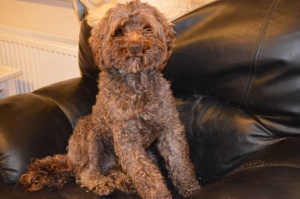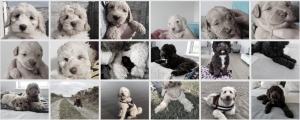Breed Information
What sizes do Labradoodles come in?
The “Standard” Labradoodle: over 22″ at the highest point of the shoulders
The “Medium” Labradoodle: 17″ to 21″ to the shoulder
The “Miniature”/”Mini” Labradoodle: 14″ to16″ at the shoulder
All three Labradoodle sizes should be of equal appearance, temperament and confirmation.
What about the Labradoodle generation?
Here is a list of generations and their definitions. Each Labradoodle generation has their own unique coat qualities and appearance.
- Australian Labradoodle or multi-generational American Labradoodle = F1B Labradoodle bred to an F1B or higher Labradoodle or an Australian Labradoodle (65% to 85% Poodle) which is non-shedding. Looks like a Teddy Bear or a fluffy silky soft mop.
- F1B =F1 Labradoodle to Standard Poodle (75% poodle to 25% lab) most are low-shedding to none shedding.
- F1 = Labrador retriever to Standard Poodle (50% – 50%) cross which can range widely on shedding and appearance. The “Benji” Look.
It has been my experience that the Australian Labradoodle combination produces the majestic beauty and regal nature, with the most consistent size and non-shedding hypoallerginic coat qualities you would want in a Labradoodle.
What about Labradoodle coat type?
- Australian and American Multi Generation coats: Woolly, Curly, Curly Fleece, and Fleece. These are non-shedding and allergy friendly.
- F1B coats: Woolly, Curly, Fleece, Wavy, Borderline wavy and hair. These can either be shedding or non-shedding.
- F1 coats: Wavy, Borderline Wavy and Straight. All these coat types vary in shedding from a light/moderate to heavy shedding.
It takes more than a Lab and a Poodle to create a Labradoodle with the temperament, health, beauty and fantastic disposition that you would want in a family dog. Adding a dog to the family is adding a new family member. Don’t be taken by the “too good to be true” deals that seem to be out there. Dogs that are cheap are cheap for a reason. All Labradoodles are not created equal. Not all Labradoodles are non-shedding and Hypo-Allergenic. Not all Labradoodles that are bred to a Mini will be a Mini. It is important to do your homework and make sure that you are getting what you think you are getting and what you paid for. It takes a great deal of time and money to raise healthy, happy Labradoodles. That will reflect in the price of your new Labradoodle family member.
Fleece and Wool – the adult coat comes in around 10-14 months old. Because the puppy coat doesn’t shed on its own, it will need to be stripped out or it will cause severe matting. During this time of coat change, which could take anywhere from 1 to several weeks, it is recommended that the puppy receive daily grooming.
How much exercise do they need?
Puppies under 1 year old should have restricted time on the lead. Jogging for miles or going on very long walks on the lead forces the puppy to perform the same mechanical movement at the same pace for long periods of time. This is not natural for puppies. Puppies are used to changing pace frequently, galloping one minute and then trotting the next. If puppies are forced to maintain a pace for a long time, it can damage ligaments and immature joints. Playing outside and short periods on a lead will provide puppy a safe amount of exercise.
Lead Times:
10 wks-4 months: Puppies could safely do a 15 minute walk on lead.
4-8 months: Puppies could do up to 30 minutes daily as long as the walk is interspersed with free play.
8-12 months: Puppies can handle an 40 – 1 hour long walk once daily and maybe a shorter walk later the same day.
Running up and down stairs, jumping off high places, slipping and sliding on polished floors, and standing on just their back legs can cause damage to puppy’s joints. Puppies should not be allowed to do any of the above. Failure to observe these things can induce hip dysplasia and other joint problems even in a healthy puppy.
How long will a Labradoodle live for?
It is expected that a healthy Labradoodle should live between 13 and 16 years.
Your puppy comes with:
- Spayed of Neutered
- Micro chip with application
- Current vaccinations and worming
- Pet Insurance when you register the microchip
- 2 yr genetic health warranty (this warranty covers any inherited life threatening disease)
- Puppy kit starter food we feed our dogs quality dog food. This ensures healthy skin and coat. It also ensures proper growth and nutrition from the balance of various vitamins, proteins and fats.
- Information on how to care for your new puppy.
- A lifetime of continued customer support.
Appearance and temperament
Because the Labradoodle is a hybrid and not a breed, puppies do not have consistently predictable characteristics. While most Labradoodles have some common traits, their appearance and behavioral characteristics remain, to some extent, unpredictable. As such, Labradoodles’ hair can be anywhere from wiry to soft, and may be straight, wavy, or curly. Straight-coated Labradoodles are said to have “hair” coats, wavy-coated dogs have “fleece” coats, and curly-coated dogs have “wool” coats. Many Labradoodles do shed, although the coat usually sheds less and has less dog odor than that of a Labrador Retriever.
Like most Labrador Retrievers and Poodles, Labradoodles are generally friendly, energetic and good with families and children. Labradoodles often display an affinity for water and strong swimming ability from their parent breeds.
Their parent breeds are both amongst the world’s most intelligent dog breeds.
Types
There is no consensus as to whether breeders should aim to have Labradoodles recognized as a breed. Some breeders prefer to restrict breeding to early generation dogs (i.e. bred from a Poodle and Labrador rather than from two Labradoodles) to maximize genetic diversity, and avoid the inherited health problems that have plagued some dog breeds.
Others are breeding Labradoodle to Labradoodle over successive generations, and trying to establish a new dog breed. These dogs are usually referred to as Multigenerational (Multigen) or Australian Labradoodles. Australian Labradoodles also differ from early generation and Multigenerational Labradoodles in that they may also have other breeds in their ancestry. English and American Cocker Spaniel/Poodle crosses (i.e. Cockapoos), Two Irish Water Spaniels and Soft-Coated Wheaten Terriers were used in some Australian Labradoodle lines. The Curly Coated Retriever were used too, but these lines did not work out and these breeds were no longer used.
Labradoodle coats are divided into three categories: wool (with tight curls, and similar in appearance to that of a Poodle, but with a softer texture); fleece (soft and free-flowing, with a kinked or wavy appearance); or hair (which can be curly, straight or wavy, but is more similar in texture to a Labrador’s coat). Labradoodles coat colors include chocolate, cafe, parchment, cream, gold, apricot, red, black, silver, chalk, parti colours, (i.e. generally, any color a Poodle can have). They can be different sizes, depending on the size of poodle used (i.e. toy, miniature or standard).




